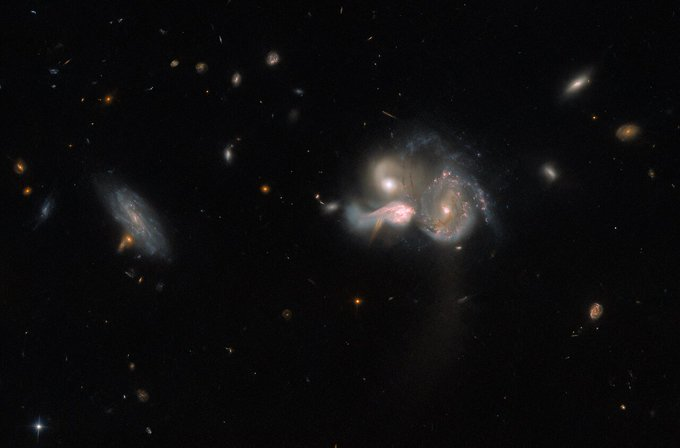Hubble captures incredible photo of three galaxies about to collide

Always bringing news from space, the Hubble Space Telescope offers us a fascinating photo of three merging galaxies. This observing program is designed to teach us more about the origin of galaxy clusters.
The mergers of galaxies, beyond giving us very beautiful images of the cosmos, also bear witness to fantastic and extraordinary astronomical events. These occur when the attraction of two systems causes them to collide . Most of the time, they just merge without causing any star collisions.
Several types of galactic mergers
There are several forms of mergers. Among others, minor mergers, during which a small galaxy is sucked up by a larger system, major mergers which see two identical spiral systems blend together and multiple mergers, it is the latter that interests us.
Indeed, we designate “multiple fusion” when more than two systems collide. In the case photographed by Hubble , we are lucky enough to observe a trio of galaxies on the merge. Other systems are also visible in the background.
“Extremely close neighbors”
One of the three, a spiral galaxy will eventually see its “elliptical arms” deformed by the gravitational power of the other two . "This colliding trio is a relatively rare combination of three large galaxies located only 50,000 light-years apart ," said the astronomers responsible for the Hubble observations. This one is in the constellation Bouvier.
“While this distance may seem safe, for galaxies it makes them extremely close neighbors,” they explain. As proof, the closest system to our own galaxy, Andromeda is located 2.54 million light years away.

The origin of galaxy clusters
These observations made by the Hubble Space Telescope are part of a larger program to understand the origin of the largest galaxies and how they formed. One thinks in particular of the titanic cluster of galaxies photographed by James Webb : Smacs 0723 located 5.12 billion light-years away in the southern constellation of the flying fish.
These gigantic celestial objects are considered the brightest galaxies in the universe. They could therefore find their origin in the fusion of gas-rich galaxies like the ones we observe here.
Source : websites

